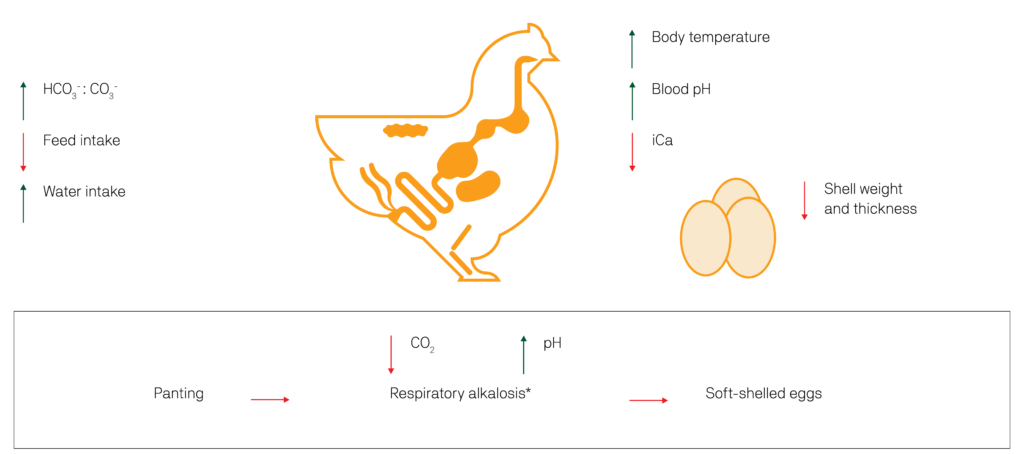Heat stress is a condition in chickens caused by high temperatures, especially when combined with high relative humidity and low airspeed. Heat stress occurs when the bird’s core body temperature increases to fatal temperatures because of poor heat loss and limited coping means. Older birds, heavy breeds, and broilers are often more susceptible to heat stress. It is the most important cause of mortality in summers leading to a huge economic loss.
Studies indicate that heat stress begins when the ambient temperature rises above 26.7°C and becomes very apparent above 29.4°C. Above 43.3°C , the bird is in danger of death.
Mechanism of heat dissipation/Thermoregulation
Since birds lack sweat glands and have a thick layer of feathers, it is difficult for them to regulate their body temperature.
The main process for birds to thermo-regulate when subjected to high temperatures is panting.
Panting is the first sign of increasing temperatures, birds begin to cool their air sacs by contact with the air and the humidity in the bags. As the frequency of panting increases, chances of dehydration increase too. Other methods to dissipate heat are opening of feathers to expose more skin surface and increased water consumption to increase the moisture content in the feces.
Effects of Heat Stress on Poultry
- Severe heat stress can cause declines in egg production and growth rate. As high ambient temperature induces stress in birds, there is an expenditure of energy, which results in a reduction in the productive efficiency of the bird.
- Decreased hatchability
- Change in the quality of the egg: You may notice smaller eggs, thinner layers, and generally poor internal egg quality. Panting leads to decreased blood carbon dioxide (CO2) levels and increased blood pH, which hampers blood bicarbonate (HCO3-) and calcium (Ca) availability for eggshell mineralization. Also due to reduced feed intake, the hens consume less calcium and the levels of calcium in the blood drop; therefore the calcification of the egg is lower.

- Heat stress also leads to decreased resistance and increases the risks of infectious diseases
- Higher mortality rates in the flock
Heat stress is best diagnosed by Post Mortem findings which will reveal “slow-cooked meat” appearance or change in the muscles to pale or white colour.
Simple Management Solutions to Heat Stress Problem
Here are some tips on how to manage heat stress in chickens in the hot season:
- External provisions such as fans, mist fans , sprinklers, housing with proper ventilation and appropriate ceiling height.
- Managing Feeding: Most often, birds are hungriest in the morning and will tend to fill up. This will make them more prone to heat stress in the afternoon. Withdrawing feed birds six hours before peak warm temperatures in the afternoon can lower the risk of heat stress. Birds can then feed during night time hours when we expect cooler temperatures to occur. You can use lighting during night time (midnight) feeding to allow intake.
- Reduce the dietary energy level in feed. Reduced protein:energy ratio.
- Vitamin C supplementation: Ascorbic Acid (Vit. C) is one of the most important vitamins in heat stress. It inhibits the increase in the body temperature of birds, increases food intake, and promotes the recovery of damaged tissue cells. The high temperature inhibits the synthesis of vitamin C in layers and requires additional compensation.
- Electrolyte therapy: Birds do not have sweat glands, so they cool off by panting. Panting can be a sign of heat stress and the act of panting can upset the electrolyte balance of birds. Electrolytes such as K, Na , P , Mg and Zn should be used to correct electrolyte imbalance due to heat stress
- Prevent overcrowding: One of the best ways to prevent heat stress is to avoid overpopulation. To instantly reduce heat, reduce the number of birds in the house.
- Avoid unnecessary activity: The summer heat puts enough stress on the birds. Be careful not to disturb them during the hottest time of the day.
- Sodium bicarbonate supplementation: Soda bicarb in the feed is especially useful for hens in egg production. Due to panting, there is excessive loss of CO2. This release of CO2 changes the acid-base balance in poultry due to which there is reduction in availability of Bicarbonate (HCO3-) for egg shell formation. Thus supplementation of sodium bicarbonate can help lessen these changes.
- Managing water: During heat stress, birds will increase their water intake by 2 to 4 times their normal intake. Sufficient water space, operating waterers and cool water temperatures will encourage the birds to drink. Flush water lines and waterers routinely to keep the water fresh and cool.
- Use of Osmolytes: Addition of osmolytes like betaine in feed increase water holding capacity of cells in the body which prevents dehydration and improves water intake.
Dr. Rishabh Chugh, Dr. Hamza Nadeem Farooqui
M.V.Sc. (Animal nutrition)
Director, Brinda feeds Pvt. Ltd.
director@brindafeeds.com
B.VSc & A.H
hamza.nadeem.h3w@gmail.com